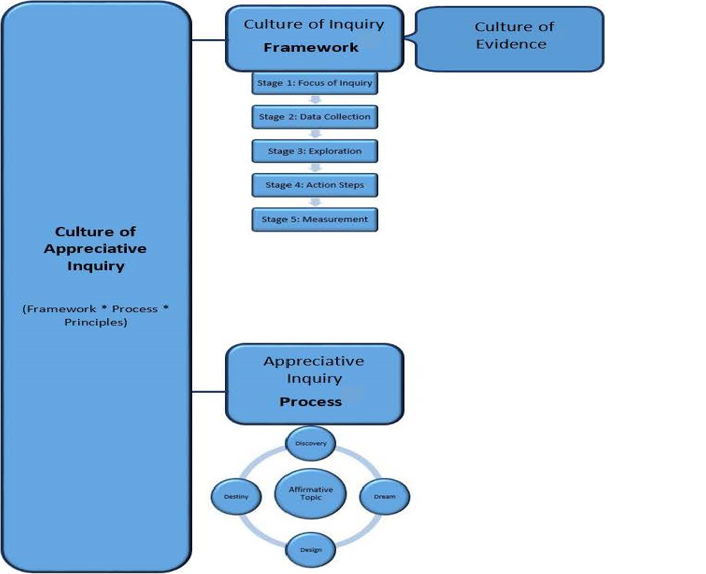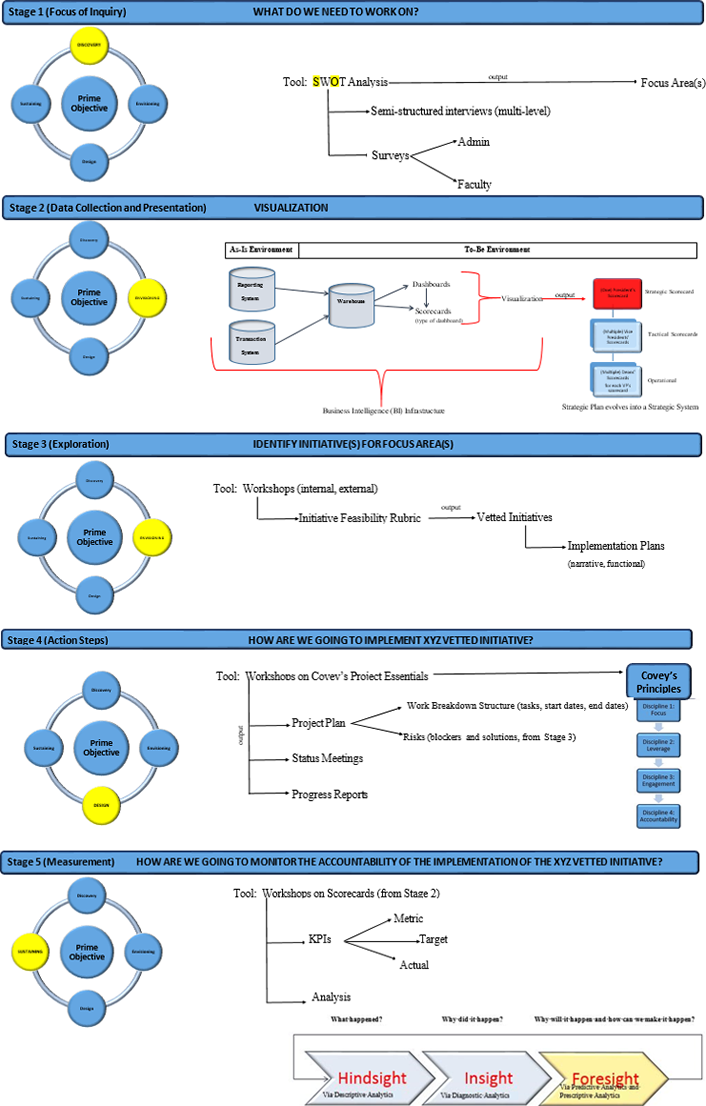Business intelligence tools, integrated with a culture of appreciative inquiry (framework, process, and principles) helped a community college not only increase its enrollment but also secure additional funding.

Business intelligence (BI) uses methods and technologies that collect, store, report, and analyze business data to help organizations make better business decisions. Like universities, community colleges face many challenges when making such decisions, and applying BI may help.1 In Texas, some community colleges have implemented BI strategic systems as their new business model. To determine the effectiveness of BI on community college decision-making, I conducted a research study that examined implementation of a BI strategic system at Lone Star College–Tomball (LSC-T), one of the six colleges in the Lone Star College System.2
In the fall of 2017, I conducted face-to-face interviews with three LSC-T leaders:
- Marian Chaney, associate vice chancellor of the Analytics and Institutional Reporting (AIR) department of the Lone Star College System Office
- Lee Ann Nutt, president of LSC-T
- Quentin Wright, vice-president of instruction of LSC-T and special assistant to the chancellor
Although I did not record the interviews, I did take notes and used them to write field reports. I then submitted the resulting report to each interviewee within a week for feedback and approval of the summarized content's accuracy. Here, I describe the study context and findings.
The Issue
Nutt, the new LSC-T president, inherited a 2015 budget that had been reduced by 55 percent due to declining contact hours. At the state level, the contact hours of the previous year (March–March) are the basis for funding the upcoming academic year (August–August). The state considers a total of 10 categories of contact hours: academic (credit), workforce (credit, non-credit), corporate, community education, and corporate college contact hours in both fundable and non-fundable categories. Academic credit fundable is the largest category, followed by workforce credit fundable, making them the primary categories for contact hours.
Because state funding accounts for 23 percent of the LSC-T budget, an increase in academic and workforce credit fundable courses (through increased enrollments and course offerings) should increase contact hours and thus state funding. To achieve this, Nutt set a goal of 104,154 total contact hours over five academic years.3
To create a sense of urgency around this goal, Nutt held a college-wide town hall meeting designed to win the hearts and minds of administration, faculty, and staff around the idea of college-wide effort to define and implement initiatives to address declining contact hours. The meeting's presentations reminded attendees of the prior year's events held for LSC-T students and the community, with the message that all of these joyful experiences would be lost if the budget deficit was not addressed now.
The Resolution
To effectively communicate laterally and vertically among faculty and administration, we needed a sequence of activities to create a culture of inquiry at the community college. LSC-T leadership found that the culture of appreciative inquiry answered the following key question:
How do we keep up the communication momentum between faculty and administration on this long journey from identifying and vetting initiatives and their action steps, to executing and monitoring those steps?
Nutt chose appreciative inquiryas a strategy to enable a no-fear climate at the college. In appreciative inquiry, the focus is on the positive attributes of a situation rather than the negative aspects; as such, Nutt believed that it could better free up stakeholders to offer ideas, to explore, and to discover. According to Wright, Nutt "sold the vision, followed it up, did not micromanage, and gave people freedom."
Routinely collecting data on student performance and institutional effectiveness (culture of evidence), combined with the institution-wide inclusion of practitioners both to engage with these data and to define, implement, and monitor action plans, provided the building blocks of a culture of appreciative inquiry at LSC-T. A positive focus is the central point in the appreciative inquiry process; it enables an institution to grow by identifying and nourishing what it does right. Such an inquiry does not replace a culture of evidence; rather, it adds people, action, and data insight to that culture.
According to Nutt, augmenting the existing culture of evidence with appreciative inquiry is what LSC-T needed—and, as Wright noted, the new president's influence was key: "Her leadership to bring appreciative inquiry about cannot be underestimated." Combining the two cultures, Chaney said, was essential to helping all four strategy growth groups work together to execute and monitor the vetted initiatives and their action steps.
Developing a Culture of Appreciative Inquiry
Building an appreciative inquiry framework can support a culture of appreciative inquiry.4 Constructing this framework occurs in five stages: In stage 1, you define the inquiry's focus, which shapes the data collection (culture of evidence) and data presentation in stage 2; this serves as the basis of exploration, stage 3, which is used to define action steps in stage 4. The final stage 5—measuring the action steps—is crucial because it answers the question: How do we know if we have done what we set out to do?
This five-stage framework follows a circular process of discovery of the institution's positive core, followed by envisioning bold possibilities (dream) and co-constructing propositions to guide the institution's future (design) to create a sustainable destiny. As Scott Ellis notes,
The real power of combining these things is in developing processes in the context of a methodology and applying methodologies in the context of a framework and most importantly, when you utilize all of those things in the context of YOUR business.5
The LSC-T project's resolution was defined within the appreciative inquiry cyclic process and supported by an inquiry framework (see figure 1). In addition, LSC-T worked with AIR to determine and select the key BI elements that applied to their process. Of the many BI components and tools that are utilized for decision-making when implementing a strategic system, AIR and LSC-T worked together to select two BI tools: BCG matrix and SWOT analysis. First, AIR developed a BCG matrix to identify which programs to address. Next, the teams used SWOT analysis to document surveys and interviews to identify LSC-T's opportunities and strengths. Four LSC-T focus strategy groups were then tasked with using the college's opportunities and strengths to define initiatives to address programs with low contact hours.

AIR and LSC-T worked together to define a feasibility rubric consisting of blockers to rate and determine which focus group initiatives to implement. AIR also developed dashboards to help with LSC-T reporting and scorecards for the college's KPIs and alerts that were defined to measure the initiatives.
As Chaney notes, one surprise in this exploration was the unfolding of an appreciative inquiry framework to support LSC-T's efforts; that framework "emphasized open and creative communication (inquiry) with a positive mindset (appreciation)." A unique quality of LSC-T's approach is the blending of David Cooperrider's appreciative inquiry process with the inquiry framework defined by Priyadarshini Chaplot, Kathy Booth, and Rob Johnstone to establish an appreciative inquiry framework. Figure 2 shows this new appreciative inquiry framework integrated with the BI tools used by LSC-T at each of the framework's five stages.

Adjustments
While LSC-T's BI strategic system was being implemented, there were two key changes to the original plan. The project launched in January 2015 with an expected completion date of April the same year. Nutt, however, wanted information that was both broad based and real. So, to better collect, analyze, and use that information—and to focus on appreciative inquiry—the April deadline was removed.
Another major adjustment was the need to roll up the effort into the college's Annual Cycle of Effectiveness (ACE) plan. Originally, the proposed project methodology of action plans was based on the Franklin Covey Project Management Essentials methodology. However, this was replaced with the ACE process to avoid competition for everyone's time when it comes to managing strategies that address KPIs, tracking ACE statements, managing the overall strategic plan, and handling the campus enrollment issue. Everything was then rolled into the Strategic Enrollment Management Plan (SEMP) and tracked by the ACE process. As Nutt pointed out, this change also allows the effort to continue and be ever present, rather than being an isolated project that might soon be relegated to the past.
Assessment
The goal of my research was to learn whether BI enhanced or changed decision-making in any way. To determine whether a prescribed change had occurred, both groups and the executive leadership tracked meetings and AIR reports. As Wright noted, LSC-T experienced five consecutive semesters of growth: from Spring 2015 to Spring 2017, LSC-T experienced growth of 10.02 percent.
Of the $1 million dollars available to all six Lone Star colleges to be allocated based on performance, LSC-T received more than $500,000—and thus the smallest of the six colleges received the highest allocation for performance. The second-ranking college was allocated approximately $300,000.
The research also examined the Vet Tech program in relation to data-based decisions. Nutt noted that this program experienced a 60 percent growth after it began making decisions based on program data evaluation.
LSC-T has remained within allocation, and FY18 is its best-funded fiscal year in many years. Based on these results, it appears that BI has enhanced decision-making and helped increase enrollment numbers, which in turn has led to additional funding allocation to LSC-T.
Recommendations for Further Research
One recommendation for further research is to examine the effect of using the blended appreciative inquiry framework for a BI strategic implementation while committing to the ACE project planning methodology for the entire project. The goal would be to determine the advantages, if any, that ACE offers. Another exploration could evaluate the impact of replacing ACE with a BI strategic system for monitoring decisions and their results.
Other future research might include community colleges using SWOT analysis and the BCG matrix for BI strategic implementations. These two BI tools enable faculty and staff to engage in addressing issues that produce a positive college impact. One goal might be to compare and contrast how colleges apply these BI tools to their campuses to determine any increases in value.
Although full BI strategic implementations by community colleges are rare and unique, they may not be for long. Ongoing research of additional implementations could help the entire community college system in America. Finally, as my research shows, it is valuable to choose and customize BI tools to align with an institution's culture. Doing so enables a community college to make better decisions to strategically overcome challenges.
Notes
- Abhishek Chakraborty, "Business Intelligence Market Is on the Cusp of Explosion" [http://www.financialexpress.com/archive/business-intelligence-market-is-on-the-cusp-of-explosion/1182100/], The Financial Express (October 14, 2013). ↩
- Leezet Marie Llorance, "Community College Business Intelligence (CCBI): A Case Study at Lone Star College–Tomball Campus on a Business Intelligence Approach to Community College Challenges" (EdD diss., National American University, 2017). ↩
- Lee Ann Nutt, State of the College Address, Lone Star College–Tomball (February 25, 2015). ↩
- Priyadarshini Chaplot, Kathy Booth, and Rob Johnstone, Building a Culture of Inquiry: Using a Cycle of Exploring Research and Data to Improve Student Success, The Research and Planning Group for California Community College. ↩
- Scott Ellis, "Frameworks, Methodologies and Processes," vsellis.com (blog), April 10, 2008 [emphasis in the original]. ↩
Leezet Marie Llorance is a Senior Analyst, Office of Analytics, in the Lone Star Community College System's Department of Analytics and Institutional Reporting (AIR).
© 2019 Leezet Marie Llorance. The text of this article is licensed under the Creative Commons BY-NC-ND 4.0 International License.
